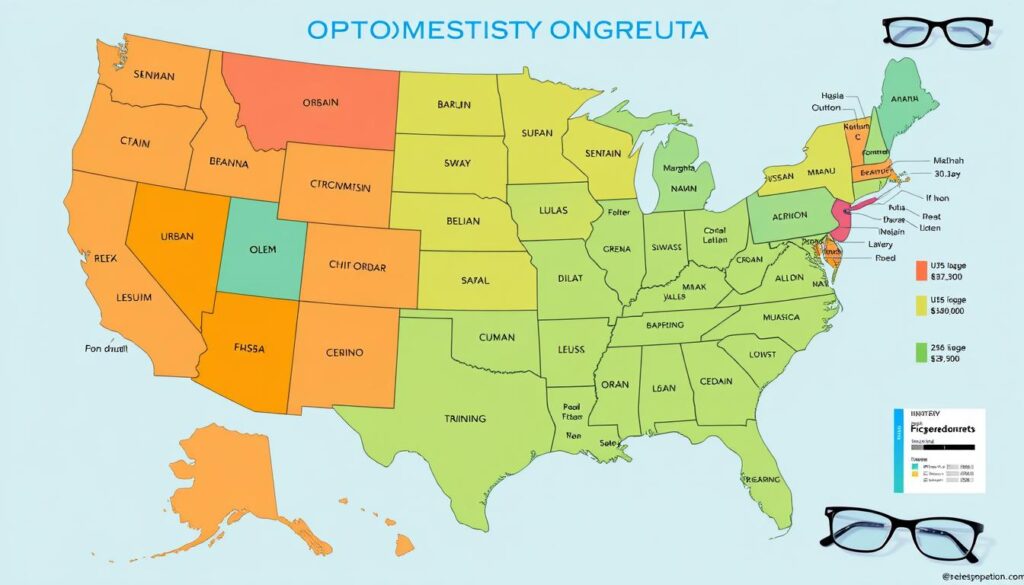Discover current optometrist salary trends, earnings potential, and factors affecting pay. Learn how location, experience, and specialization impact your income as an eye care professional.
Did you know optometrist salary make up to $200,000 a year by 2025? The salary for optometrists is changing fast, offering great chances for eye care workers in the U.S. It’s key to know the average salary and income trends for those thinking about this career.
The vision care field is full of promise for optometrists. They get good pay for their special skills and knowledge. They do important work, like eye exams and advanced vision care, to keep communities healthy.
Your salary can change based on your experience, where you work, and where you are. Whether you’re new or have been doing this for years, optometry offers good money and chances to grow professionally.
Key Takeaways
- Annual optometrist salary range reaches up to $200,000 in 2025
- Medical eye exams constitute approximately 50% of practice work
- Potential for partnership within 5 years of employment
- Competitive compensation includes performance bonuses
- Multiple benefits like health insurance and 401K plans available
Current State of Optometry Earnings in the United States
The optometry field in the United States offers strong financial rewards. Knowing the current salary trends for optometrists gives us a better understanding of their earning potential and career paths.
Optometrists can earn around $200,000 a year on average. However, salaries vary based on several factors. These factors include your experience, location, and the type of practice you work in.
National Average Salary Trends
Recent data shows interesting salary trends for optometrists:
- Average annual income: $200,000 per doctor
- Full-time practitioners earn around $204,523
- Part-time professionals average $137,364
Regional Salary Variations
Salaries for optometrists vary by state. California is known for offering the highest salaries to eye care professionals.
| Location | Average Annual Salary |
|---|---|
| San Jose, CA | $182,799 |
| San Francisco, CA | $182,071 |
| Oakland, CA | $177,701 |
| New York, NY | $170,127 |
Employment Settings Impact on Income
Your job setting greatly affects your salary as an optometrist. Those who work for themselves usually earn more than those in traditional jobs:
- Self-employed optometrists: Average $243,650
- Employed optometrists: Average $156,819
- Potential earnings difference: 55% advantage for self-employed professionals
“Choosing the right employment model can significantly impact your financial trajectory in optometry.” – Professional Optometry Insights
Your career choices and professional strategies will ultimately determine your earning potential in this dynamic healthcare field.
Factors Influencing Optometrist Salary
Knowing what affects your earnings as an optometrist can help you plan your career. The pay for optometrists and ophthalmologists varies a lot. This shows big differences in what they earn.
Several key elements directly influence your entry-level optometrist salary and long-term earning potential:
- Geographic Location
- Professional Experience
- Practice Setting
- Specialization
- Advanced Certifications
Your job setting greatly affects your income. Private practices pay differently than corporate or clinical jobs.
“Where you work is just as important as what you do in determining your salary potential.” – Healthcare Career Insights
| Career Stage | Average Annual Salary | Potential Growth |
|---|---|---|
| Entry-Level | $90,000 – $100,000 | 15-20% increase within first 3 years |
| Mid-Career | $118,000 – $130,000 | 25-30% potential increase |
| Experienced Professionals | $130,000 – $150,000 | Dependent on specialization |
Specializing in areas like pediatric optometry or sports vision can boost your pay. Where you live also matters. States like California, New York, and Massachusetts pay more.
Staying updated with new healthcare tech and getting extra certifications can help you earn more. Being open to change and learning new things is key to a higher salary.
Private Practice vs. Employment: Income Comparison
Thinking about a career in optometry? It’s key to understand the money side to make smart choices. The choice between starting your own practice or working for someone else can really affect your salary.
Optometrists can choose from many paths, each with its own money matters. You must think about what you want to earn, the benefits you’ll get, and your career goals when deciding to work for yourself or someone else.
Self-Employed Optometrist Earnings
Starting your own practice in Texas and other places can lead to higher earnings. You need to consider:
- Potential for higher hourly rates (about 7.65% more than usual)
- Chance to negotiate your pay
- Opportunities to save on taxes
“Self-employment offers greater financial control, but requires more administrative responsibility.” – Professional Optometry Association
Corporate and Clinical Employment Benefits
Working for a company can mean steady pay and extra perks:
- Set salary
- Full benefits
- Less worry about paperwork
In Texas, your salary as an optometrist can change based on where you work. Corporate jobs usually mean a steady income.
Starting Your Own Practice Considerations
Starting a private practice needs careful financial planning:
- Starting costs can be $250,000 to $500,000
- Annual earnings could be $120,000 to $225,000
- Options for saving for retirement, like Solo 401(k)
Optometrists must think about the costs of starting a practice and how much they might earn in the long run. Getting advice from a financial expert can help with these big decisions.
Geographic Salary Distribution and State Rankings

Optometrist salaries vary a lot across the United States. Places like Florida, New York, and Michigan have different pay levels for eye care workers.
In Florida, salaries for optometrists change a lot depending on where you work. Cities like Miami and Orlando pay more than rural areas. The state’s lower cost of living makes it appealing for those in optometry.
New York City’s optometrist salaries are shaped by its high costs and dense healthcare markets. Doctors here get competitive pay, but it’s affected by the area’s expenses.
| State | Average Salary | Cost of Living Index |
|---|---|---|
| Florida | $125,340 | 98 |
| New York | $138,870 | 135 |
| Michigan | $119,650 | 90 |
Michigan offers interesting salary chances, especially in big cities like Detroit and Ann Arbor. The state’s lower cost of living means more money in your pocket.
- Urban locations typically offer higher salaries
- Rural areas may provide competitive compensation to attract talent
- State-specific regulations impact earning potential
“Location significantly influences an optometrist’s financial trajectory and professional growth.” – Healthcare Workforce Insights
Many things affect how much you can earn, not just where you live. Your salary also depends on your specialty, experience, and where you work.
Experience Levels and Career Progression Impact on Optometrist Salary
Your career in optometry is a journey of growth. Your salary can increase a lot as you gain experience and skills. Knowing how career stages affect your pay can help you plan your career.
Entry-Level Compensation
Starting out, optometrists can earn between $70,000 to $90,000 a year. In Ohio, new graduates get competitive wages. Your first salary depends on:
- Educational background
- Geographic location
- Employment setting
- Clinical specialization
Mid-Career Earnings
As you get better at your job and build your network, your pay goes up. Mid-career optometrists in Ohio and other states can make between $95,000 and $120,000. Your salary grows with professional development, extra certifications, and specialized skills.
Senior-Level Income Potential
With 10-15 years of experience, your salary can reach high levels. Senior optometrists, especially those in private practice or leadership, can earn between $130,000 and $180,000 a year.
“Your optometry career is an investment in continuous learning and professional growth.” – American Optometric Association
| Career Stage | Salary Range | Key Factors |
|---|---|---|
| Entry-Level | $70,000 – $90,000 | Education, Location, Setting |
| Mid-Career | $95,000 – $120,000 | Specialization, Experience |
| Senior-Level | $130,000 – $180,000 | Leadership, Private Practice |
Professional tip: Keep learning, network, and make smart career moves to boost your salary.
Veterans Affairs Optometrist Pay Reform and Opportunities

The Veterans Affairs (VA) healthcare system has introduced a new pay reform for optometrists. This change is thanks to the Elizabeth Dole 21st Century Veterans Healthcare and Benefits Improvement Act. It’s a big step forward for eye care professionals working with veterans.
“This legislative reform represents a critical step in recognizing the essential role of optometrists in veteran healthcare” – American Optometric Association
Here are the main points of the VA optometrist pay reform:
- Inclusion of optometrists in the physician pay scale
- Potential for increased pay awards and bonuses
- Improved annual evaluation processes
- Enhanced recruitment strategies for VA facilities
Optometrists looking to work in Illinois or Houston have great opportunities. The VA offers competitive salaries in these areas. This is especially true with the new support from the legislative reform.
| VA Optometry Statistics | Percentage |
|---|---|
| Primary Eye Care Services Provided | 70% |
| Ophthalmic Procedures Performed | 73% |
| Low Vision and Rehabilitation Services | 99% |
The reform fixes a pay issue that has lasted since 1976. It will help over 1,000 optometrists. The VA wants to keep the best eye care professionals working for veterans.
This pay reform is a big step in valuing the important work of optometrists in veteran healthcare.
Compensation Packages and Additional Benefits
It’s key for optometrists to know what they’ll get in a job. Salary is important, but the whole package matters too. It can really boost your earnings.
Optometrists get more than just a salary. Whether you’re looking at pediatric optometrist jobs or optometrist roles in Maryland, the right perks can greatly improve your job satisfaction.
Health Insurance and Retirement Plans
Great employers offer excellent health benefits. These include:
- Comprehensive medical insurance
- Vision and dental coverage
- 401(k) retirement plans with employer matching
- Life and disability insurance
Bonus Structures and Incentives
Many places give extra money for good work and hard work:
- Performance-based bonuses
- Sales volume incentives
- Regional pay zone adjustments
- Stock purchase options
Professional Development Benefits
Investing in your career can open new doors. Some top benefits are:
- Tuition reimbursement programs
- Continuing education allowances
- Support for attending conferences
- Professional membership sponsorships
“The right benefits package can transform a good job into an exceptional career opportunity.” – Career Development Expert
Pro tip: Don’t just look at the salary. The whole package, including benefits, can greatly increase your earnings.
Industry Growth and Future Salary Projections
The optometry field is on the verge of big growth, with lots of new job chances in the U.S. Experts predict a strong increase in jobs for eye care workers. This is especially true in places like Los Angeles and Massachusetts.
Several trends are shaping the future of optometry:
- Employment expected to grow 9% from 2021 to 2031
- Approximately 1,700 new optometrist positions created annually
- Increasing demand driven by an aging population
- Greater awareness of preventive eye health
New technologies are changing the field. Innovative practices like dropless cataract surgery and green vision care options are opening up new paths for skilled workers. The focus is moving towards more complete and patient-focused care.
“The future of optometry is not just about vision correction, but holistic eye health management.”
Some areas, like Los Angeles and Massachusetts, are seeing a big need for eye care. Optometrists in these places can look forward to good pay and many job options.
Aspiring optometrists should think about:
- Investing in continuous professional development
- Embracing technological innovations
- Understanding emerging market needs
- Developing specialization skills
With global myopia rates expected to hit over 50% by 2050, the optometry field is set for big growth and change.
Career Advancement Strategies for Higher Earnings
To move up in your optometry career, you need a plan and to keep learning new skills. Whether you work in Georgia or compare salaries in the UK, there are ways to make more money.
Improving your skills is key to earning more. Here are some steps to take:
- Specialize in areas like pediatric optometry or low vision care
- Get advanced certifications to stand out
- Learn how to manage a business well
- Stay up-to-date with the latest technology
Making smart career choices can really help your income grow. Revenue per encounter (RPE) is important for tracking your earnings. To make more money, try these:
- Add more medical eye care services
- Offer more treatment options
- Use smart billing strategies
- Get good deals on vendor contracts
“Success in optometry isn’t just about clinical skills – it’s about strategic financial management and continuous learning.”
Planning your finances is also important for career growth. Knowing about retirement savings can help you plan for the future. In 2025, you can save up to $70,000 in a SEP IRA, which is a big tax break for optometrists.
By combining your clinical skills, business knowledge, and financial planning, you can earn more in the optometry field.
Conclusion: The Financial Outlook for Optometrists in 2025
Exploring the optometrist salary landscape in 2025 shows a bright future. The job is expected to grow by 9% with a median salary of $124,300. This makes optometrists a key part of the healthcare team.
The healthcare job market is booming, with over 1.2 million jobs opening each year. Making smart career choices can boost your salary. For example, focusing on certain eye care areas or choosing the right location can help.
Understanding what affects your salary is key. Things like where you work, the area you’re in, and your skills matter a lot. With a strong job market and chances for growth, optometry is a great career for 2025.
Your career in optometry is full of promise. There are many ways to increase your earnings and job satisfaction. By staying updated, getting specialized training, and planning your career, you can thrive in this vital field.


